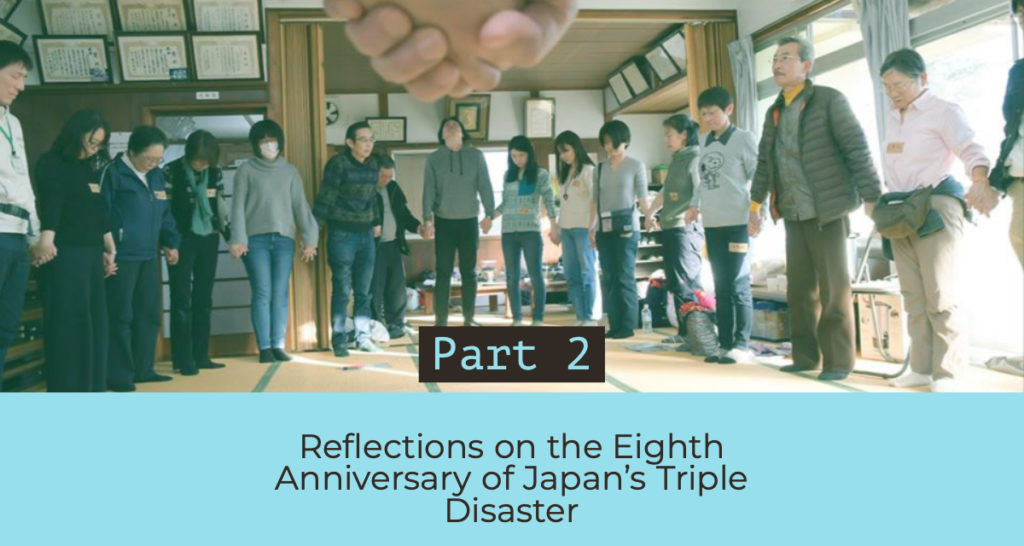Reflections on the Eighth Anniversary of Japan’s Triple Disaster: Part 2
March 11, 2019 marked eight years since Japan’s “Triple Disaster.” Communities and individuals are still marked by this disaster and continue the work of healing. Mission Co-worker in Japan, Jeffrey Mensendiek, shares some reflections from a recent trip he took to Fukushima with Derek Duncan, Area Executive for East Asia and the Pacific. Part one can be found here. This is part two:
OLYMPIC TORCH RUNNER
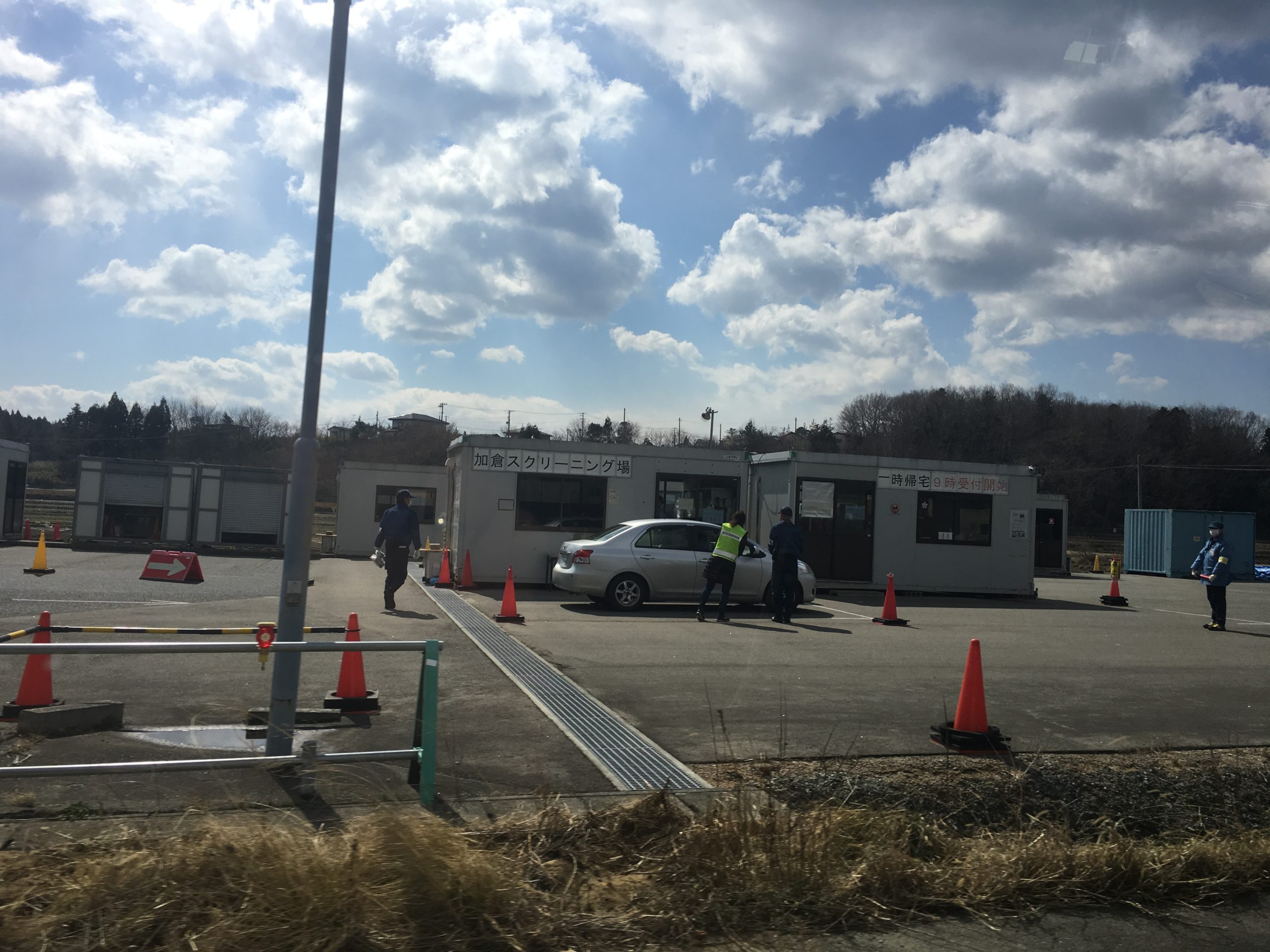 We went to the Namie train station. The tracks south of Namie are still closed. The twenty mile stretch which runs right by the nuclear reactors, they say, will be opened by 2020. Until then there is a bus that will take people to Tomioka, the train station to the south where the train tracks resume. The bus goes along Route #6. The government allows four wheel vehicles to drive on Route #6, but two wheelers (motorbikes and bicycles) are not allowed because the high radiation levels.
We went to the Namie train station. The tracks south of Namie are still closed. The twenty mile stretch which runs right by the nuclear reactors, they say, will be opened by 2020. Until then there is a bus that will take people to Tomioka, the train station to the south where the train tracks resume. The bus goes along Route #6. The government allows four wheel vehicles to drive on Route #6, but two wheelers (motorbikes and bicycles) are not allowed because the high radiation levels.
We drove on Route #6 for a while. We could see construction workers standing on street corners directing traffic. One wonders about the risks to their health. We passed what Etsuya called “a check point.” It consisted of a large parking area where several official looking officers were standing to direct the vehicles that came in. Etsuya pointed out the micro-buses parked there. “Notice the parked buses. Those are the buses used to bring nuclear plant clean-up workers from places like Fukushima city. They are all brought here, then they changes buses, and go to work on clean-up at the nuclear plants. At the end of the day they return to this check point, and each person is checked to see how much radiation they have been exposed to.”
Just last week the media announced the route for how the Olympic torch would be taken by torch runners through all 47 of Japan’s prefectures. They reported with great enthusiasm that Fukushima’s J-Village would be the starting point for this pre-Olympic event. The J-Village is a large soccer field complex located only a mile and a half away from the reactors. The Olympic torch runner will receive the Olympic torch at J-Village and then run south along Route #6—the road too contaminated for two-wheel vehicles. Gasp!!!
Japan wants to prove to the world that Fukushima is OK. But this is nothing other than a political stunt characterized by hubris.
EMPOWERING MIGRANT WOMEN
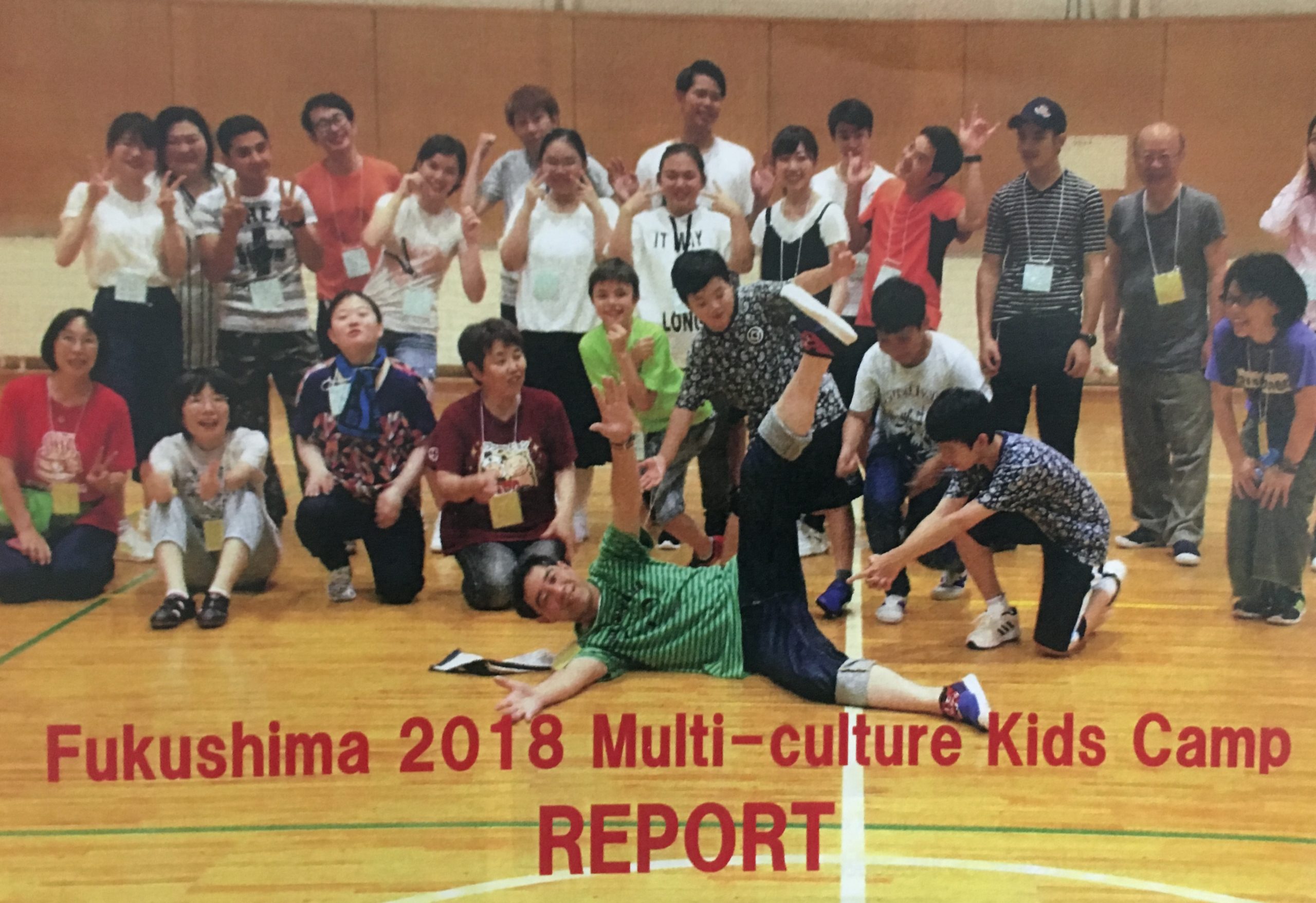 From Namie we drove two hours north to Sendai. Etsuya has been making these trips to the Namie area whenever groups from around Japan ask for an exposure trip to understand the issues in and around Fukushima.
From Namie we drove two hours north to Sendai. Etsuya has been making these trips to the Namie area whenever groups from around Japan ask for an exposure trip to understand the issues in and around Fukushima.
That evening in Sendai, we had dinner with Mr. Sato who runs a small project that Global Ministries has supported called EIWAN. EIWAN was started after the disaster specifically to support migrant and immigrant women who live in Fukushima. These are mostly women from the Philippines, Korea and China who have married into Japanese families. In a highly homogenous society, these women often find themselves left behind and excluded by the larger society. Their children often experience troubles at school because they come from a “mixed” family. EIWAN offers Japanese language classes for the mothers, and after-school study sessions for the children. EIWAN advocates for these families, to celebrate their presence in society and support them to be an independent and vital part of society.
EIWAN has been able to bring together communities in three areas of Fukushima. They plan an annual camp for youth. They also have an annual event to celebrate cultural diversity. The women focus on language study, and take language competency tests. By passing these tests they gain a sense of confidence in the language, and often go on to find a job. This is a small project to empower these women.
FREE THYROID TESTS
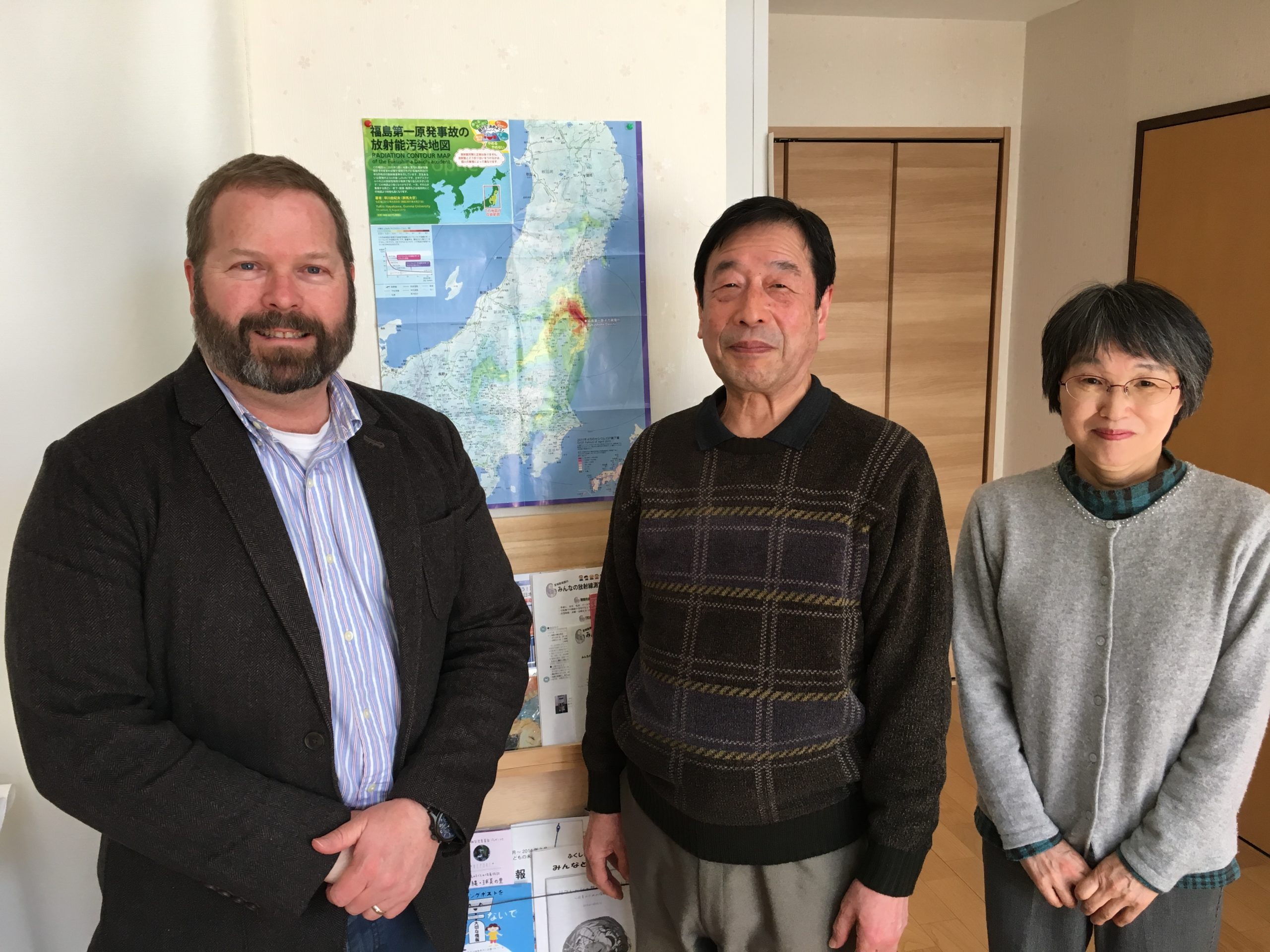 For parents living in and around Fukushima at the time of the nuclear disaster, one priority has been to protect one’s children from the harms of radiation. During the past eight years the Japanese government has offered free thyroid tests for all children under the age of 18 living in Fukushima Prefecture at the time of the disaster. They are now into the fourth round of testing. Out of 370,000 children, 200 children have been diagnosed with cancer. Though this is a very high number of children, the government insists that the high number has nothing to do with the nuclear disaster. They claim that Japanese technology is so advanced that this focused effort to test children has revealed numbers that otherwise would have gone unnoticed if they had not been tested.
For parents living in and around Fukushima at the time of the nuclear disaster, one priority has been to protect one’s children from the harms of radiation. During the past eight years the Japanese government has offered free thyroid tests for all children under the age of 18 living in Fukushima Prefecture at the time of the disaster. They are now into the fourth round of testing. Out of 370,000 children, 200 children have been diagnosed with cancer. Though this is a very high number of children, the government insists that the high number has nothing to do with the nuclear disaster. They claim that Japanese technology is so advanced that this focused effort to test children has revealed numbers that otherwise would have gone unnoticed if they had not been tested.
Right across the Fukushima border to the north is Miyagi Prefecture where Sendai is located. Sendai is the largest city in Miyagi. We spent the morning in Sendai with Rev. Fuda who told us about the activities of “Izumi.” This non-profit run by our partners, has been offering free thyroid tests each month for 50 to 100 families living in Miyagi. The government only tests people living in Fukushima. Rev. Fuda reminded us; “There are no borders in the sky! Radiation doesn’t stop at the border!” Izumi has been providing relief for families who live with the uncertainty that they might have exposed their own children to high levels of radiation. The parents keep their own records for their children. Izumi also provides legal, medical and spiritual counseling. Two times a year they arrange “fresh-air camps” for families who are looking for a chance to get away and let their children play freely outside rolling in the grass. These camps are a chance for the parents to connect and find a community of people who share their values. In most local communities, even if you might feel anxious about radiation levels, people in society tend to dislike people who question the status quo. They say; “Why are you so anxious? The government says everything is under control. You are paranoid.” Some young mothers find themselves isolated in their own neighborhoods with no one who is open to discussing the issue.
SURVIVORS AND VOLUNTEERS
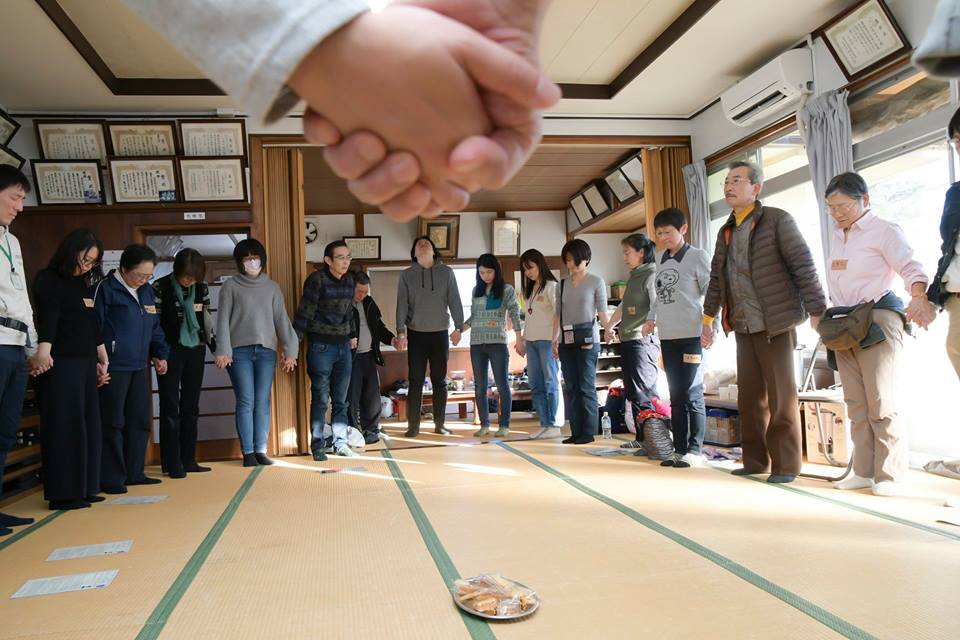 As of this month the Emmaus Center is closing out its tsunami relief efforts which have been ongoing for the past eight years. There are several reasons for this. For one, many of the survivors in the Sendai area have been able to move out of temporary housing and into new housing provided by the government. Another reason is to ask the question; “How long does relief continue?” There comes a time when relief activities must come to a close, and a new kind of supportive relationship takes its place.
As of this month the Emmaus Center is closing out its tsunami relief efforts which have been ongoing for the past eight years. There are several reasons for this. For one, many of the survivors in the Sendai area have been able to move out of temporary housing and into new housing provided by the government. Another reason is to ask the question; “How long does relief continue?” There comes a time when relief activities must come to a close, and a new kind of supportive relationship takes its place.
On March 9th, Derek and I attended an “Open House” sponsored by the Emmaus Center which brought together former volunteers with local villagers of Sasayashiki. We gathered in the local meeting room, shared a meal, had a time of sharing and reflection, and then closed with a prayer. Volunteers spoke about how their experience of volunteering had changed them and opened them to a new world of compassion and community. Local residents too shared about the great hope that they found in the young volunteers who had come to help. Both had been enriched by the experience.
Derek had the chance to give Mr. Sugawara (the primary contact person in the village) a box of Buckeye chocolates. Global Ministries was honored to be able to accompany the tsunami survivors through the work of our partners. Then we closed with a prayer. As we stood there in a circle holding the hands of the people on both sides, I couldn’t help but think of the many times that we bowed our heads in prayer during the relief activities. On the 11th of each month at 2:46, the volunteers and staff of the Emmaus Center would hold hands out by the coast and pray. We would pray for those who lost their lives, and for the families still grieving, and those trying to rebuild their lives.
I was honored to give the closing prayer that day on March 9th. “We will never forget,” I prayed, “the great loss and despair that so many people have experienced.” But I went on to say; “But we will also remember the hope that we encountered and shared right here in the midst of the devastation.” Our relationships with one another have taught us something fundamental about the human condition; that we are able to discover God’s hope in the most unlikely places, and under the most unlikely circumstances.
For your reference, though tsunami relief is coming to a close, relief for those suffering from the nuclear disaster is still ongoing.
WORSHIP
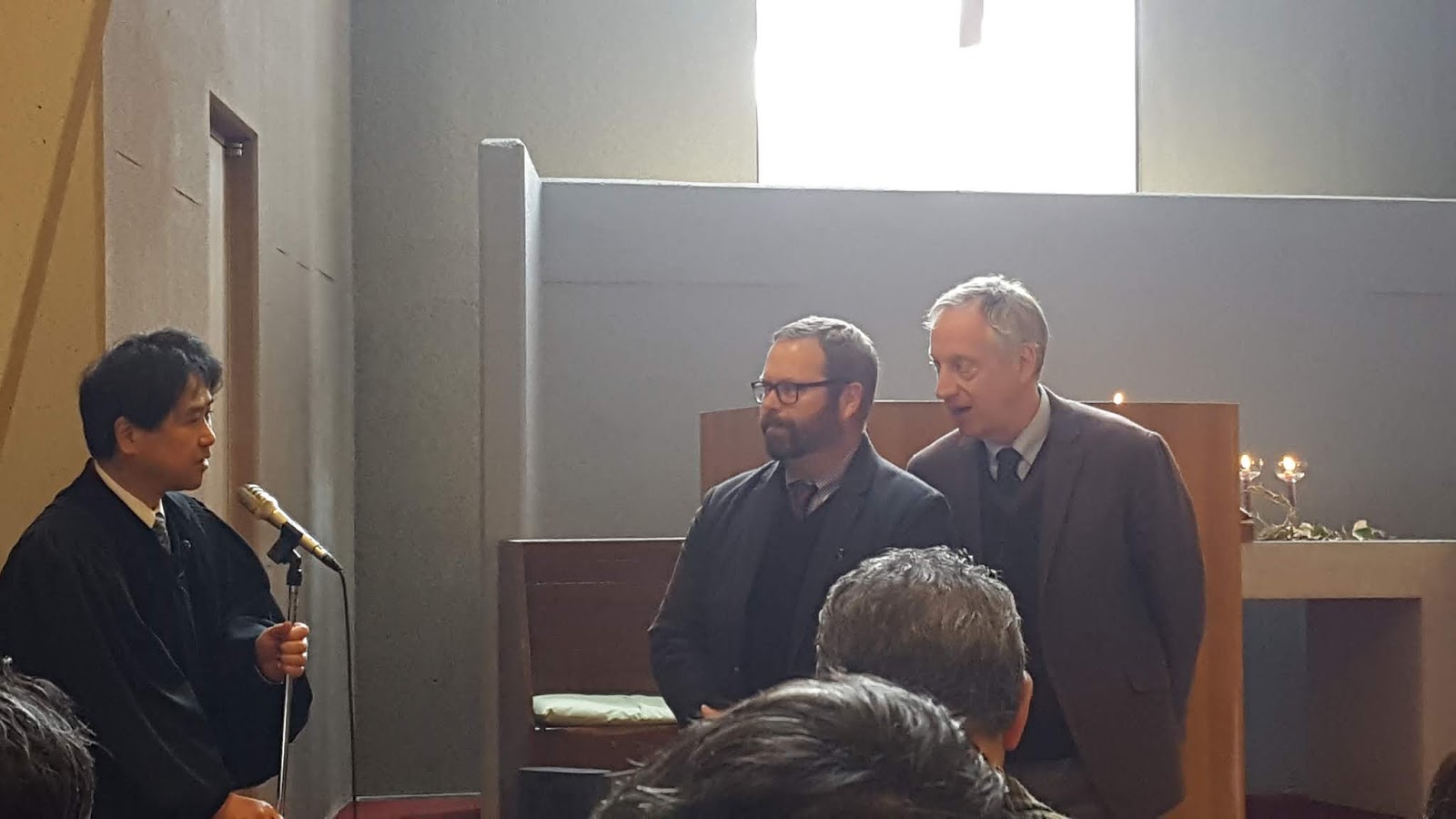 March 10th (Day Four), Derek and I attended worship at the Sendai Kita Church. This is the church where the moderator of the Tohoku Conference, Rev. Konishi, is pastor. The church celebrates a history of 130 years this month since the Congregational Church, USA planted their first church in the area.
March 10th (Day Four), Derek and I attended worship at the Sendai Kita Church. This is the church where the moderator of the Tohoku Conference, Rev. Konishi, is pastor. The church celebrates a history of 130 years this month since the Congregational Church, USA planted their first church in the area.
The Bible verse he chose to commemorate the eighth anniversary of the earthquake was from Lamentations 3:10-24. Rev. Konishi started by pointing out that each person has his/her own unique experience of the great disaster and how we reflect on our experience in different ways. But there is great meaning in that diversity when we gather at worship to all sit together as one before God. Even though we are diverse, we are able to share this time together in worship, and reflect on what it means to prioritize God in our lives.
The poet in Lamentations writes in verse 19; “The thought of my pain, my homelessness, is bitter poison. I think of it constantly, and my spirit is depressed.” This for the poet was the experience of the Babylonian captivity which continued for over half a century. However, out of that experience of pain, depression and loss, the poet reaches two conclusions in his thought. First, he sees this experience as a chance to return to a merciful God. “I am one who knows what it is like to be punished by God.” (Lam 3:1) The poet does not blame others, but looks within and accepts the need to change from his own volition. The second realization is in verse 21; “Yet hope returns when I remember this one thing: The LORD’s unfailing love and mercy still continue.” When the poet makes the conscious decision to face his/her own suffering, and struggle to find meaning there, he/she discovers God’s unfailing love and mercy. This was the truth that the Israelites had discovered after more than 50 years of soul searching.
CLOSING CEREMONY
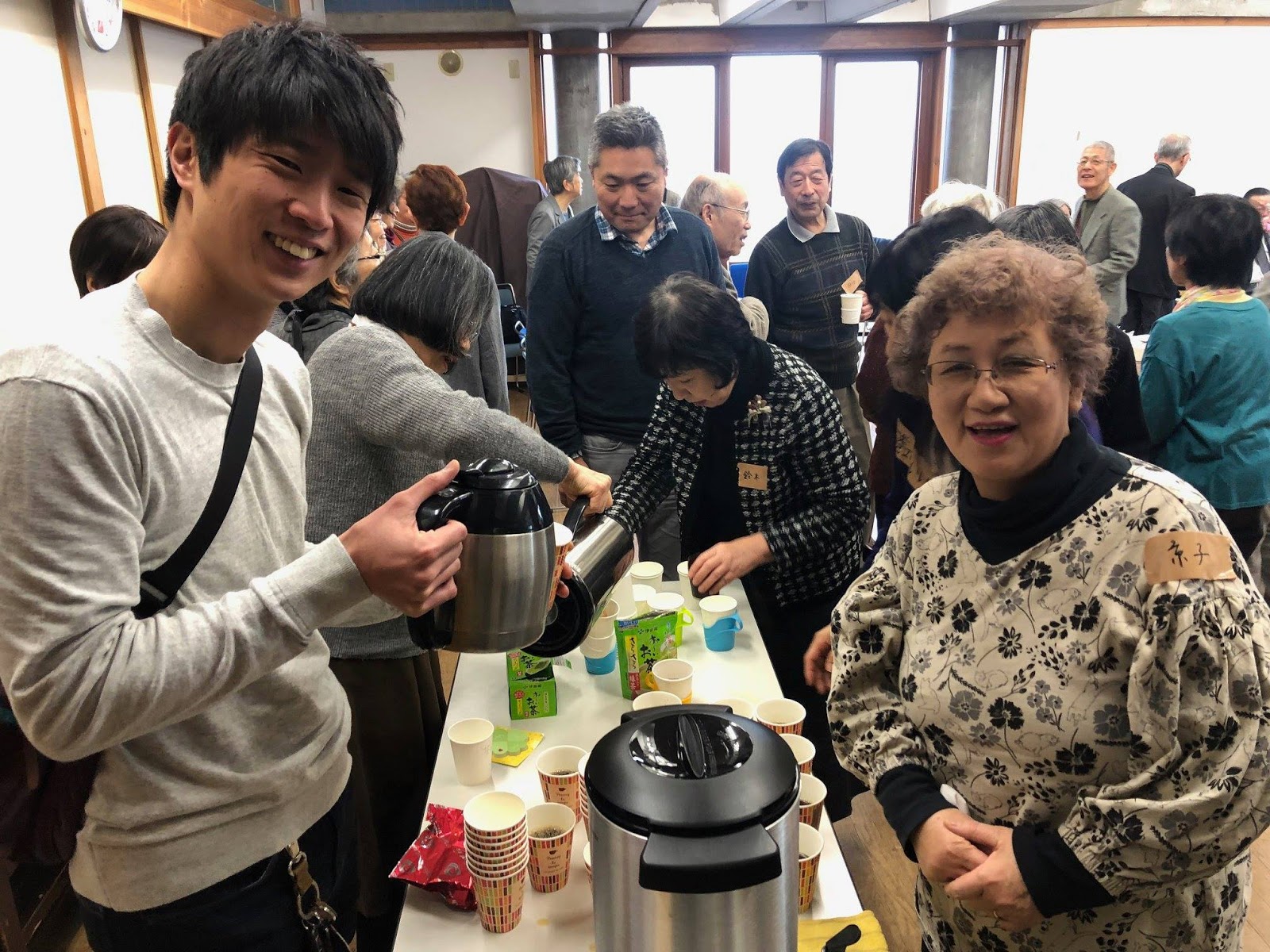 I visited the Emmaus Center in Sendai on March 23rd to attend the “Time of Thanksgiving and Remembrance” on the occasion of the eighth year after the great disaster of March 11, 2011. Our partners (the Kyodan) have decided to close the activities of the Relief Center. This event was a way for church members, Emmaus Center staff, former volunteers, and survivors from Sasayashiki to gather as one and share time together in thanks and remembrance.
I visited the Emmaus Center in Sendai on March 23rd to attend the “Time of Thanksgiving and Remembrance” on the occasion of the eighth year after the great disaster of March 11, 2011. Our partners (the Kyodan) have decided to close the activities of the Relief Center. This event was a way for church members, Emmaus Center staff, former volunteers, and survivors from Sasayashiki to gather as one and share time together in thanks and remembrance.
The program was for two and a half hours. Part One was worship, and Part Two was a time for fellowship and speeches. I was there to convey our warmest greetings from Global Ministries, and to commend them for their devotion and commitment to accompanying the survivors for eight years. I had several letters from US churches and from Derek Duncan (the Area Executive for East Asia and the Pacific).
Derek wrote:
“Many of us with Global Ministries have had the pleasure of visiting and witnessing the dedication of the Emmaus Center through the years. After 2011 we were grateful that Rev. Jeffrey Mensendiek was in a position to provide critical support for the coordination of relief work through the Center. We have been humbled by the opportunity to walk with you through these significant years of your ministry. As you close this chapter of relief work through the Disaster Relief Center, we extend our warmest congratulations to your staff and volunteers. We celebrate and give God thanks for the work of the Emmaus Center!”
Jeffrey Mensendiek serves with J.F. Oberlin University in Tokyo, Japan. His appointment is made possible by your gifts to Disciples Mission Fund, Our Church’s Wider Mission, and your special gifts.

